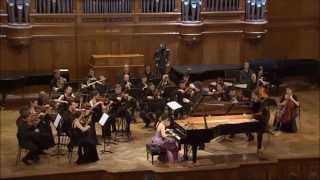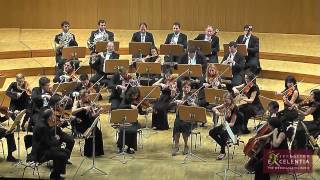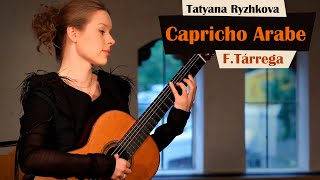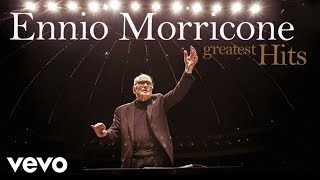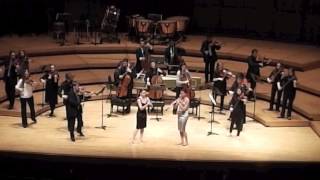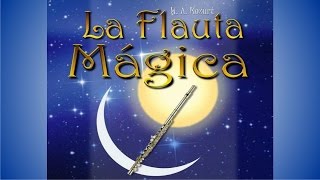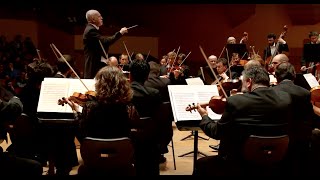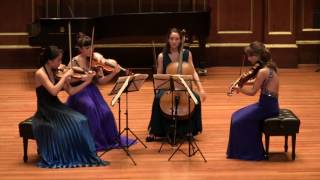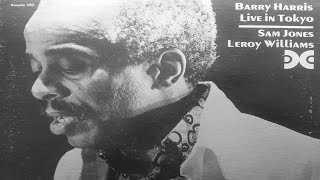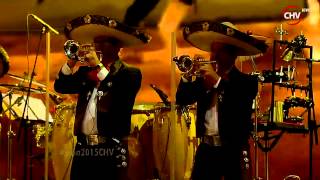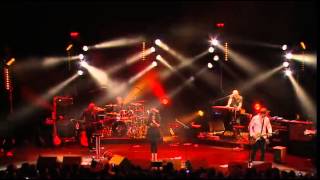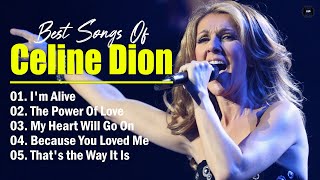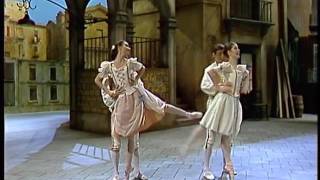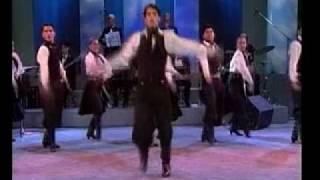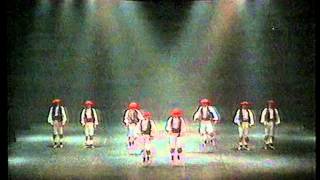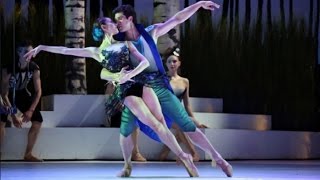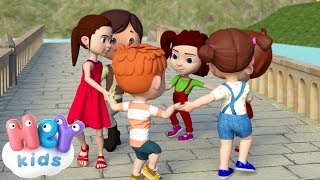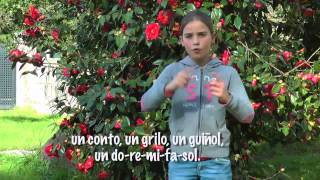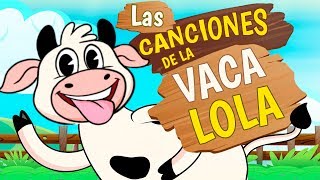On January 27th, the births of Mozart and Arriaga are commemorated.
Recommended music videos for initiation to classical music
Wolfgang Amadeus Mozart (1756-1791) is considered one of the three giants of musical composition along with Bach and Beethoven . A child prodigy born in Salzburg , Austria , at the age of six he mastered the keyboard and the violin and began to compose; taking advantage of these abilities, his father, Leopold , also a composer, exhibited him on exhausting tours of different European courts. At the age of seventeen he was hired as a musician at the court of Salzburg, but his restlessness led him to travel in search of a better position, always composing prolifically. During his visit to Vienna in 1781, after being dismissed from his position at court, he decided to settle in this city, where he achieved the fame that he maintained for the rest of his life, despite going through difficult financial situations.
In his later years he composed many of his best-known symphonies, concertos and operas, as well as his Requiem . The circumstances of his early death have been the subject of much speculation and elevated to the status of myth. According to Nicholas Till and some other music historians and critics, Mozart was always a voracious learner from other musicians and developed a brilliance and maturity of style that ranged from the light and elegant to the dark and passionate. His influence on all subsequent Western music is profound; Ludwig van Beethoven wrote his early compositions in the shadow of Mozart , of whom Joseph Haydn wrote that "posterity will not see such talent again for a hundred years."
An eminently prolific composer (more than 600 works written between the age of five and his death), he cultivated all kinds of musical genres; piano works, chamber music, symphonies, concertante works, choral works, operas… each and every one of them a masterpiece of their genre. His operas The Magic Flute, Don Giovanni, Così fan Tutte, and The Marriage of Figaro are among the 10 most performed operas in the world. We cannot forget his Clarinet Concerto , or his Requiem , which are regular parts of the repertoire of the best orchestras. From 1769 to 1781 he worked for the Archbishop of Salzburg ; after the success of his opera Idomeneo of Crete , the doors of Vienna were opened to him, where he settled and achieved great fame that would accompany him until his death at the age of 35.
The catalogue of Mozart's works or Köchel Catalogue ( Köchel Verzeichnis, in German) was created by Ludwig von Köchel in 1862 and lists the musical works composed by Wolfgang Amadeus Mozart . Each of Mozart 's works is designated by a number preceded by the abbreviation K. or KV ; a number that designates the chronological order of its creation and that is really valid for most of the works although some works by other authors appear.
Wolfgang Amadeus Mozart 's Piano Concerto No. 21 in C Major, K. 467, was completed on March 9, 1785, and premiered a day later at the Imperial and Royal Court Theatre in Vienna , in a concert promoted by Mozart himself. This is one of the composer's most popular piano concertos and is structured in three movements, of which today we offer the second, ANDANTE IN F MAJOR, which begins with a triplet figuration in the bass supporting a languid melody. After a relaxed exposition by the orchestra, the soloist takes up the melody with the ensemble. There are brief moments of "sadness," but overall the tone of the movement is bright and calm. Today's version is offered by Korean pianist Yeol Eum Son.
Juan Crisóstomo de Arriaga (1806 - 1826), known by many as the Basque Mozart , was born in Bilbao . His father, Juan Simón , came from Errigoiti , a town near Gernika , where his mother, Maria Rosa , came from. His father, an organist from Berriatua , Bizkaia, moved to Bilbao to, as a good Errigoitiarra, dedicate himself to the business with which he prospered and thus was able to promote Juan Crisóstomo 's educational development in Paris, where he would die 10 days before his 20th birthday. The musical legacy, which has been preserved, consists of three string quartets, the octet Nada y mucho , written at the age of 11, the Overture No. 1 , the Symphony in D, several arias and cantatas as well as some motets and an opera, Los esclavos felizes , written at the age of thirteen, of which only its overture survives, which we offer today.
An overture is an instrumental introduction to an opera or other dramatic work, whether musical or not; although some independent instrumental compositions of the 19th and 20th centuries were also called overtures by their composers. The earliest operas, dating from the early 17th century , did not have overtures; but they did have an introduction by the vocalists in which they summarized the action that was to follow. Instrumental introductions began to be used regularly in the mid- 17th century ; the German composer Christoph Willibald Gluck was one of the first to use material from his operas for overtures. In this way, they established the emotional profile of the opera that followed.
The composition of the Overture to The Happy Slaves follows the French model, composed of two parts: a first part (0´08´´), short and slow in ternary rhythm as an introduction, and a second part (1´32´´), fast and more developed. The performance is offered by the Santa Cecilia Classical Orchestra conducted by its concertmaster Florian Donderer .
Francisco Tárrega (1852-1909) was a virtuoso guitarist and composer (“the Sarasate of the guitar”), born in Villarreal (province of Castellón ). His childhood was marked by an accident when he fell into a ditch due to the carelessness of the girl who looked after him and his eyesight was damaged. His father, fearing that he would go blind, moved to Castellón so that he could attend music classes and earn a living as a musician. Later, in 1874, he entered the Conservatory of Madrid , where he studied composition with Emilio Arrieta . By the age of eighteen he was already giving guitar classes and giving concerts regularly. From 1880 onwards he began his international tours, visiting cities such as Paris, Lyon and London , while his recitals around the state were innumerable.
Capricho Árabe is a composition for classical guitar written by the Spanish composer Francisco Tárrega in 1892, after a long trip through Andalusia and North Africa . It was dedicated to his friend, the musicologist and composer Tomás Bretón . It has been performed and recorded on countless occasions by most classical guitarists, such as Andrés Segovia and Narciso Yepes . On December 15, 1909, in the city of Castellón during Tárrega 's funeral, three bands of music stood around the composer's coffin and solemnly played Capricho Árabe . Those who witnessed the act remembered it as one of the most emotional moments of their lives.
Tatyana Ryzhkova was born in 1986 in Belarus and is one of the most promising classical guitarists of today. On YouTube she has already made a place for herself in the header of classical guitarists; she has more than 500 concerts around the world behind her and her number of fans is constantly growing, rewarding them with an intense stage performance, a mix of passion, virtuosity and peculiar entertainment. Alongside the classical repertoire, Tatyana has developed as a singer-songwriter: her own melody, lyrics and voice converge wonderfully in a gift for the senses.
Today, Tatyana offers us the Arabic Caprice by Francisco Tárrega .
Ennio Morricone (1928-2020) was an Italian conductor and composer of more than 500 film and television scores and other symphonic and choral compositions. The son of a musician, he began studying the trumpet as a child and at the age of nine he entered the National Academy of Santa Cecilia ; at the age of 18 he began writing for radio programs and, little by little, for films. The film director Sergio Leone , a childhood friend, asked him to collaborate on his films and thus they created a different model of western, the Spagetti Western . His contracts were expanded with other directors until he became one of the most appreciated soundtrack composers. Throughout his career he received important and countless awards endorsing his brilliant work.
Today we present a florilegium of some of his best-known soundtracks conducted by Morricone himself. I (0:00) The Ecstasy of Gold (The Good, the Bad and the Ugly) .- . II (3:22) The Good, the Bad and the Ugly. -. III (6:04) Once upon a Time in the West .- . IV (9:15) For a Few Dollars More. -. V (13:05) A Fistful of Dynamite .-. VI (17:43) Cinema Paradiso - Main Theme .-. VII (20:13) Chi Mai (Maddalena & Le professionel) .-. VIII (23:48) . La Califfa - The Lady Caliph / The Queen .-. IX (26:27) My Name is Nobody .-. X (29:37) L'arena (Il Mercenario - The Mercenary / A Professional Gun) .-. XI (34:23) A Monument (I Crudeli – The Hellbenders) .-. XII (36:55) Misterioso e Ostinato (Faccia a Faccia - Face to Face) .-. XIII (39:17) Un Amico (Revolver) .-. XIV (41:55) Love Theme for Nata (Cinema Paradiso) .-. XV (46:03) Romanzo (1900 - Novecento) .-. XVI (50:12) Romanza Quartiere (Quartiere).-. XVII (53:51) Il Figlio e la Nostalgia (The Law of the Desert) .-. XVIII (57:41) Ninna Nanna per Adulteri (Cuore di Mamma) .-. XIX (01:00:45) Watch Chimes - Carillon's Theme (For a Few Dollars More) .-. XX (01:01:57) Tradimento Primo (Tepepa).-. XXI (01:04:13) Run, Man, Run (The Big Gundown)
Recommended classical music videos
Tomaso Albinoni (1671-1751) was an Italian Baroque composer who was born and died in Venice ; best known in his time for his operas, while in our time his popularity comes from his famous Adagio , which he did not write but was composed in 1945 by the Italian musicologist Remo Giazotto based on fragments of a sonata for strings and organ by Albinoni . In contrast to the composers of his time, he never sought a position in the Church or at Court , as he was self-sufficient and fiercely jealous of his own independence. The son of a wealthy family, he studied singing and violin and composed some 50 operas and a great deal of instrumental music; mainly sonatas for solo and trio and concertos for oboe and violin.
The Concerto for Two Oboes, Op. 9, No. 9 , which we present today, consists of the three movements usual at this time: Fast (0´03´´) - Slow (3´50´´) - Fast (6´41´´) , in which the oboe duo dialogues with a string orchestra. The solo roles are played by Emily Knaapen and Emily Tsai , American oboists who combine their profession as instrumentalists with teaching and are accompanied by the University of Maryland Symphony Orchestra .
Mozart and Freemasonry. Freemasonry appeared in Europe at the end of the 17th century as a selective, discreet and hierarchical philanthropic group; with a federal structure, its objectives are humanistic: the search for truth, the study of human behavior, science and the arts and the social and moral development of people and society; all of this based on a feeling of brotherhood; its teachings are symbolized with elements of masonry. With these objectives in mind, at the age of 28 Mozart entered the Masonic Lodge of Vienna as an apprentice; the following month he rose to the rank of Fellow Mason and four months later he was named Master Mason. Influenced by the Enlightenment and the ideas of Rousseau, Mozart longed for rationalism without joining the occult character of many of his companions.
Along the same lines, according to Thomson, “music should instill feelings of humanity, wisdom and patience, virtue and honesty, loyalty to friends and finally an understanding of freedom.” Mozart conveys many of these ideas directly in some of his operas, while at other times he does so through Masonic symbols; in any case, he began to compose cantatas expressly for Masonry even before he became a member, since many of his friends were Masons. As works greatly influenced by Masonic ideas or symbols, we will mention the Requiem, La Clemenza di Tito and The Magic Flute that we offer today. Other famous composers were also Masons, such as his father Leopold Mozart, Haydn, Schubert, Liszt, Wagner, Puccini, Sibelius, Satie… there are even indications that point to Bach as a fervent Mason.
Opera was born at the end of the 16th century, as an initiative of a circle of scholars (the Camerata Fiorentina) who, upon discovering that ancient Greek theatre was sung, had the idea of setting dramatic texts to music. Thus, Jacopo Peri created La Dafne (1597), of which only the libretto survives today, followed by Euridice (1600), by the same author. In 1607, Claudio Monteverdi composed La favola d'Orfeo, to which he added a musical introduction that he called a "symphony", and divided the sung parts into "arias", giving structure to modern opera. The subsequent evolution of opera has run parallel to the various musical currents that have followed one another over time: between the 17th century and the first half of the 18th century, the Baroque period took place, a period in which classical music was reserved for the social elite, but which produced new and rich musical forms, and which saw the establishment of a language of its own for opera, rich and complex not only in compositional and vocal methods but also in theatrical and stage production.
In the second half of the 18th century, Classicism took place, a period of great creativity marked by the serenity and harmony of its compositions. The 19th century was marked by Romanticism, characterized, above all, by the individuality of the composer, already considered an enlightened genius and increasingly the object of greater veneration, as were the greatest vocal figures of singing, who became stars of a society where the bourgeoisie relegated the aristocracy to social preeminence. This century saw the rise of musical variants from numerous nations that until then had hardly any musical tradition, in what was called Musical Nationalism. Some currents such as French Impressionism and Italian Verismo closed the century.
In the 20th century, opera, like the rest of music and the arts in general, entered the avant-garde, a new way of conceiving artistic creation in which new compositional methods and techniques emerged, which were expressed in a great variety of styles, in an era of greater diffusion of the media that allowed reaching a wider audience through various channels (radio, television, internet...) and not just the physical one, and in which the wide musical repertoire of previous periods is still valued, which is still current in the main opera houses of the world.
Die Zauberflöte (“The Magic Flute”) is an opera that was premiered in Vienna conducted by Mozart himself two months before his death. The libretto was written by a fellow member of his Masonic lodge, Emanuel Schikaneder, with a plot that points to the struggle between good and evil, light and darkness, knowledge and ignorance; all of which are fundamental approaches to Masonic doctrine. A narrative full of Masonic symbolism in the incarnation of the characters, in the development of the action and even in the musical structures.
The version that we offer today from the Zurich Opera House is conducted by the Austrian maestro Franz Welser-Möst (1960).
Symphony . The word derives from the Latin symphonĭa meaning consonance as opposed to diaphōnia meaning dissonance. In the Middle Ages the word symphony was used to describe instruments capable of producing more than one sound simultaneously and by the end of the 18th century the word had already acquired its present meaning: a work for orchestra consisting of several sections . The symphony reached its maturity with Beethoven . His symphonies usually had a first movement "Allegro" in sonata form (sometimes with a short introduction), a slow second movement (sometimes in the form of a theme and variations ), a third movement in ternary rhythm (usually a scherzo ; before Beethoven a minuet and trio were common), ending with a fast fourth movement in rondo or sonata form.
The Symphony in D minor , which we offer today, is one of the most paradigmatic and representative works of the artistic legacy of Juan Crisóstomo de Arriaga . The exact year of its composition is around 1824, when Arriaga was in France , in the middle of his Parisian period. As for the main key in which the symphony is composed, there are also doubts. In this case, following a reading by Víctor Estapé and Aurelio M. Seco , the symphony is in the key of D minor , even though the introduction in D major may be misleading. The symphony is structured in four movements: I (0´30´´) ADAGIO. (3´39´´) ALLEGRO VIVACE .-. II (10´25´´) ANDANTE .-. III (18´50´´) MENUETTO: ALLEGRO .-. IV (23'05'') ALLEGRO WITH MOTORCYCLE.
Today it is offered to us by the Galicia Symphony conducted by the Zamora maestro Jesús López Cobos (1940-2018).
Charles Ives (1874 – 1954) was an American composer who is widely regarded as one of the first to achieve international prominence. Ives 's music was largely ignored during his lifetime, and many of his works remained unperformed for many years. Ives would eventually come to be regarded as one of the American Originals , a composer who embraced a uniquely American style, with American folk tunes woven throughout his compositions and a restless search for musical possibilities. His best-known works are The Unanswered Question for orchestra and the Concord Sonata for piano.
Charles Ives's String Quartet No. 2 is a work for string quartet written between 1907 and 1913. It was premiered at the McMillin Theatre at Columbia University in New York City on May 11, 1946, by an ensemble of students from the Juilliard School . Its first professional performance was by the Walden String Quartet on September 15, 1946, at Yaddo , in a concert that prompted composer Lou Harrison to write, "This work is... the finest piece of American chamber music yet... Music of this kind only comes along every fifty years or a century, so rich in faith and so full of a sense of completion." In his Memos , Ives referred to the quartet as "one of the best things I own".
Form and content. The quartet is a programmatic work depicting four men who “talk, argue, argue, fight, shake hands, fall silent… and then walk up the mountainside to see the firmament!” In keeping with the dramatic conception suggested by the movement titles, Ives treats the four instruments with an unprecedented degree of individuality: each has its own special character and the overall quality of the work results from a kind of forced amalgamation of the four different textural components and is structured in three movements: I (0´41´´) Discussions (Andante moderato—Andante con Spirito—Adagio molto) .-. II (10´08´´) Arguments (Allegro con Spirito) .-. III (15´53´´) The Call of the Mountains (Adagio—Andante—Adagio).
Recommended music videos for all tastes
Barry Harris (1929-2021) was a jazz pianist and composer in the bebop style (small groups with music based on lively rhythms and surprising harmonies) which was a reaction to the swing of the previous era, which was stuck in large groups, calm rhythms and predictable harmonies. Our pianist today was born in Detroit, a city where he dedicated himself to teaching with small groups with whom he made various recordings within the new style. Later he moved to New York where he established close relationships of friendship and ideas with the leading figures of jazz and where he continued to bet on teaching and active music within bebop . He died on December 8, 2021, due to complications caused by COVID.
Alejandro Fernández Abarca ( Guadalajara , Mexico; April 24, 1971) is a Mexican mariachi and Latin pop singer, son of the late ranchero singer Vicente Fernández . Initially he specialized in traditional styles of regional Mexican music such as mariachi . Later he has diversified into Latin pop with urban touches, ballads and boleros . He has a solid recording career and has been awarded three Latin Grammys and six Billboard Awards . He has managed to sell approximately 40 million albums around the world.
Viña del Mar 2015: 1 (2:42) Concave and convex.-. 2 (6:49) My voice is going away .-. 3 (11:49) What am I going to do with my love .-. 4 (16:42) Vent .-. 5 Today I feel like you (19:43) .-. 6 (24:34) It does me so much good .-. 7 (28:37) I will love you .-. 8 (32:53) I'm going to lose you .-. 9 (36:45) Sing heart .-. 10 (43:48) I dedicated myself to losing you .-. 11 (48:37) If you only knew .-. (52:55) Mariachis .-. 12 - Where do you go so alone (59:30) .-. 13 - Kill Them (1:03:10) .-. 14 (1:06:12) What a pity .-. 15 (1:10:21) Light helmets.-. 16 (1:12:35) A little bit of pain .-. (1:17:01) Silver seagulls .-. 17 (1:18:07) It's the woman .-. 18 (1:22:07) Like someone who loses a star .-. (1:27:58) Golden seagulls .-. 19 (1:29:25) The day you love me .-. 20 (1:33:07) Divine women.-. 21(1:35:14) I'm going to get out of the way .-. 22 (1:36:38) A good love is worth more .-. 23 (1:38:15) Beautiful love .-. 24 (1:39:50) These jealousies .-. 25 (1:41:39) Here between us.-. 26 (1:43:44) How do I forget you
Nina Hagen (born 1955) is a German singer and actress, born in East Berlin when present-day Germany was divided into two states, famous for her mix of punk style and operatic singing . Her father died when she was just a child, and her mother married the singer-songwriter Wolf Biermann , who was accused several times of counterrevolutionary in the then German Democratic Republic , for making criticisms and mockery of the regime. Nina learned ballet at an early age and demonstrated surprising ability as a singer, being considered a child prodigy for her opera performances. Today, Nina is considered one of the most innovative singers of the punk era.
Céline Dion (born 1968) is a Canadian singer born in Quebec . Before achieving worldwide success, she emerged as a teen star in her native country, releasing a series of French-language albums that brought her great popularity. In 1990 she released Unison, her first English-language production, which marked the beginning of her outstanding and successful career in the English-speaking market. Dion is the Canadian with the most records sold in the world. Her music has been influenced by genres as varied as rock, R&B, gospel and classical music , among others. She has won five Grammy Awards and is the only artist to have two consecutive albums with sales of more than 30 million copies. According to Sony Music Entertainment , the singer has sold more than 200 million musical productions worldwide.
Recommended peculiar videos
Igor Stravinsky (1882-1971) was a Russian pianist, conductor and composer; for many critics, the most important of the 20th century . During his long life he delved into different styles and musical genres from post-romanticism to serialism and jazz . He studied, among others, with Rimsky Korsakov and worked for different genres and musical groups; but after meeting Sergei Diaghilev , founder of the Ballets Russes , he collaborated closely with him. Stravinsky also wrote for various types of ensembles and genres from operas and symphonies to small piano pieces and works for jazz groups, achieving great fame not only as a composer, but also as a pianist and conductor. Time magazine considered him one of the most influential personalities of the 20th century .
Pulcinella , the work we are presenting today, was a ballet commissioned by Diaghilev , who wanted a libretto and music based on a character from the 18th century Commedia dell'arte ; so Stravinsky based himself on the music (trios, operas and other materials) of Pergolesi to rewrite this music adapting it to more modern forms; and so, while he rescued some themes, he added others with updated rhythms and harmonies. The premiere took place in 1920 with costumes and sets designed by Picasso .
The Basler Ballett (Ballet Theater Basel) is the Ballet of the Basel Theater , made up of 30 top-class dancers from different countries. It also plays an important educational role in its Ballet School , where more than 200 children are trained.
Malambo is a traditional Argentine folk dance, belonging to the so-called southern or southern music . It was born in the Pampas around the year 1600 and within Argentine folk dances, it is an exception because it lacks lyrics; the music of a legüero bass drum and guitars (sometimes, only the bass drum or percussion) accompany this dance performed only by men (although in the version of the National Ballet today women appear in a secondary role). A series of these combined movements is called "mudanza" or "zapateo" , and the conjunction of these constitutes the malambo itself. There are no rules for performing a zapateo . Each of the combinations of the basic movements is unique and depends on the originality of the gaucho who performs it. The zapateos are separated from each other by a foot stamp called "repique" which contains a quick and particular sound that indicates the end of one zapateo and the beginning of another.
Argia Dantza Taldea is a Basque dance group from San Sebastian, made up of around 45 members, directed by Juan Antonio Urbeltz (1940). It has collected many dances from the Basque Country “in situ” and grouped them into cycles in which the authenticity of the versions, both choreographic and musical, instrumental, and even costume, has prevailed. At the International Folklore Festival in Middlesbrough (England) in 1968, it won first prize for dance among 28 groups from 22 nations. In 1998, the Alfred Toepfer Foundation in Hamburg awarded it the European Prize for Popular Art .
Argia Dantzari Taldea, Alakiketan show, 1993. This was the continuation of "Alakiketan" (Irradaka) (1987) and "Zortziko" (1988), premiering at the Arriaga Theatre in Bilbao in 1992. In 1993 it was joined by " Muriska ", a drama or choreography inspired by the pastorals of Zuberoa , and the whole production premiered for the first time at the Olite International Festival . This video is in the latter format. Direction, choreography and costume design: Juan A. Urbeltz. Musical direction and arrangements: Marian Arregi. Collaborations: Dance groups Goizaldi, Haritz and Arkaitz, Joaldunak de Ituren, Oin Arin and Antiguo, Añorga and Astigarraga. Musicians: From the groups Argia and Haritz, Antiguotarrak and the soka-orkestra of Lasarte. Dance teachers: Fernando Aristizabal, Iñaki Arregi, Claude Iruretagoiena, Jexux Larrea, Josema Mendiola and Lurdes Odriozola. Costumes: Amaia Bueno, Claude Iruretagoiena and Javier Cuadrado. (Extracted from the comment at the bottom of the video)
Il Giardino degli Amanti. This is a suite created by the Roman choreographer Massimiliano Volpini with fractions of Mozart 's compositions in which different characters from his works appear and dance to the mysterious and intimate music to which they are invited.
Roberto Bolle (1975) is an Italian classical ballet dancer who has performed with the most renowned ballet companies in the world. In 2003 he was awarded the title of étoile by La Scala and in 2009 he was made principal dancer of the American Ballet Theatre. Nicoletta Manni (1991) is the prima ballerina of the La Scala Ballet .
Recommended music videos for children
Various Wikipedia articles have been used to write these texts.
The texts of Videomusicalis are written in Basque, Spanish and English.





